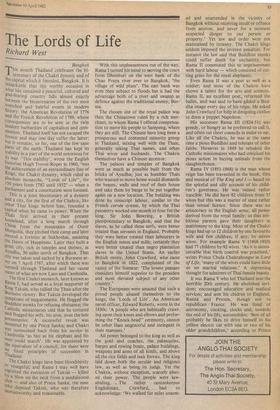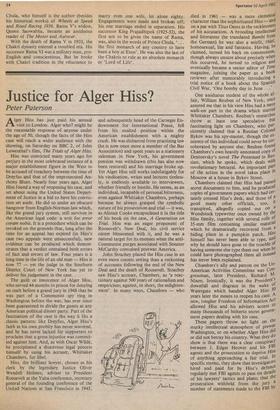The Lords of Life
Richard West
Bangkok This month Thailand celebrates the bi- centenary of the Chakri dynasty and of the capital which it founded, Bangkok. It is remarkable that this worthy occasion in what has remained a peaceful, cultured and god-fearing country falls almost exactly between the bicentenaries of the two most wretched and baleful events in modern history: the American Revolution of 1776 and the French Revolution of 1789, whose consequences are to be seen in the twin modern barbarities of capitalism and com- munism. Thailand itself has not escaped the former and may one day suffer the latter; but it remains, so far, one of the few sane Parts of the earth. Thailand has kept its stability in a part of the world notorious for its war. 'This stability', wrote the English historian Hugh Trevor-Roper in 1960, 'was the achievement of an extraordinary line of Kings, the Chakri dynasty, which ruled as absolute monarchs, "Lords of Life", for 150 years from 1782 until 1932' — when a Parliament and a constitution were formed.
This is a joint bicentenary of a dynasty and a city, for the first of the Chakris, like other Thai kings before him, founded a capital when he came to power. When the Thais first arrived in their present homeland, after a long march through China from the mountains of Outer Mongolia, they pitched their camp and later erected a fortress at Sukhothai, meaning the Dawn of Happiness. Later they built a great city, rich in temples and shrines, at AYIndha, 30 miles north of Bangkok. That city was taken and sacked by a Burmese ar- mY on 7 April 1767, after which there was turmoil through Thailand and her vassal states of what are now Laos and Cambodia.
The first Chakri monarch, later known as Rama I, had served as a loyal supporter of King Taksin, who rallied the Thais after the Burmese victory. But Taksin developed the sYmptoms of megalomania. He flogged the Buddhist monks for refusing obeisance; the Catholic missionaries said that he tortured and flogged his wife, his sons, even the heir Presumptive. A successful revolt was mounted by one Praya Sanka; and Chakri was summoned back from his service in Cambodia 'as fast as his elephant and his Men could march'. He was appointed by the equivalent of a council, for there were no fixed principles of succession in Thailand.
The Chakri kings have been bloodthirsty or venegeful; and Rama I may well have regretted the execution of Taksin — killed by a blow on the neck from a sandalwood club — and also of Praya Sanka, the man who deposed Taksin, who was therefore untrustworthy and treasonable.
With this unpleasantness out of the way, Rama I turned his mind to moving the court from Dhonburi on the Vest bank of the Chao Praya river over to Bangkok, 'the village of wild plum'. The east bank was even then subject to floods but it had the advantage both of a river and swamp as defence against the traditional enemy, Bur- ma.
The chosen site of the royal palace was then the Chinatown ruled by a rich mer- chant, to whom Rama I offered compensa- tion to move his people to Sampeng, where they are still. The Chinese have long been a prosperous and contented minority group in Thailand, mixing well with the Thais, generally taking Thai names, and often Thai wives and husbands. The Chakris themselves have a Chinese ancestor.
The palaces and temples of Bangkok were as much as possible built from the bricks of Ayudha; just as humbler Thais who wanted to move home would dismantle the beams, walls and roof of their house and take them by barge to be put together again on a new location. The building was done by conscript labour, similar to the French corvee system, by which the Thai peasantry worked one month in four for the king. Sir John Bowring, a British plenipotentiary to Bangkok, said that the slaves, as he called these serfs, were better treated than servants in England. Probably they were better treated than labourers in the English mines and mills; certainly they were better treated than negro plantation slaves in the United States. An earlier British envoy, John Crawfurd, who came to Bangkok in 1822, complained of the vanity of the Siamese: 'The lowest peasant considers himself superior to the proudest and most elevated subject of any other country.'
The Europeans were amazed that such a proud people abased themselves to the kings, the 'Lords of Life'. An American naval officer, Edward Roberts, wrote in the 1830s: 'A people who are habitually crawl-, ing upon their knees and elbows and perfor- ming the "Knock-head" ceremony, cannot be other than ungraceful and inelegant in their manners.'
All power belonged to the king as well as the gold and coaches, the palanquins, barges and rowing boats, palace buildings, weapons and arms of all kinds, and above all the rice fields and teak forests. The king laid down both the secular and religious law, as well as being its judge. Yet the Chakris, without exception, scarcely abus- ed their power. The people were law- abiding. The rather cantankerous Englishman, Crawfurd, had to acknowledge: 'We walked for miles unarm- ed and unattended in the vicinity of Bangkok without receiving insult or offence from anyone, and never for a moment suspected danger to our person or property.' Yet law and order were not maintained by tyranny. The Chakri kings seldom imposed the severest penalties. For instance the laW said that Buddhist monks could suffer death for unchastity, but Rama II commuted this to imprisonment with hard labour — which consisted of cut- ting grass for the royal elephants.
Even Rama II was a poet as well as a soldier; and most of the Chakris have shown a talent for the arts and sciences. Rama II, an excellent poet, reformed the ballet, and was said to have gilded a Bud- dha image every day of his reign. He asked John Crawfurd for help in designing clothes to dress a puppet Napoleon. •
His successor Rama III (1824-51) was greedy, or hungry as he preferred to call it, and often cut short councils in order to eat. Like all the Chakris, he was at the same time a pious Buddhist and tolerant of other faiths. However in 1849 he rebuked the Catholic missionaires who had criticised his pious action in buying animals from the slaughterhouse.
Rama IV (1851-1868) is the man whose reign has been travestied in the book, film and musical of The King and I –'- based on the spiteful and silly account of his child- ren's governess. He was indeed rather irascible. He did have 82 children from 35 wives but this was a matter of state rather than sexual licence. Since there was no aristocracy in the English sense, all power derived from the royal family; so that am- bitious parents gave their daughters in matrimony to the king. Most of the Chakri kings had up to 12 children by one favourite wife and few children, if any, by minor wives. For example Rama V (1868-1910) had 77 children by 92 wives. 'As it is incon- ceivable that birth control was practised,' writes Prince Chula Chakrabongse in Lord of Life, 'many of the wives could have little or no marital relations.' A depressing thought for admirers of Thai female beauty.
It was Rama V who led Thailand into the horrible 20th century. He abolished serf- dom; encouraged education and medical services; and sent his chidren to England, Russia and Prussia, though not to republican France. He was fond of astronomy, cooking, clocks and, towards the end of his life, automobiles: 'Best of all probably he likes to drive himself in his yellow electric car with one or two of his older grandchildren,' according to Prince
Chula, who himself is the author (besides his historical works) of Wheels at Speed and Road Racing 1936. Rama V's widow, Queen Saowab ha, became an assiduous reader of The Motor and Autocar.
With the death of Rama V in 1910, the Chakri dynasty entered a troubled era. His successor Rama VI was a military man, pro- English and conscientious. But he broke with Chakri tradition in the reluctance to marry even one wife, let alone eighty. Engagements were made and broken off; his one marriage ended in separation. His successor King Prajadhipok (1925-32), the first not to be given the name of Rama, was, also in the words of Prince Chula, ' the first monarch of any country to have been a boy at Eton'. He was also the last of the Chakris to rule as an absolute monarch or 'Lord of Life'.



































 Previous page
Previous page